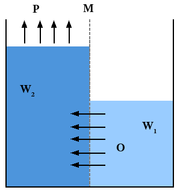
Pressure retarded osmosis
Encyclopedia

Seawater
Seawater is water from a sea or ocean. On average, seawater in the world's oceans has a salinity of about 3.5% . This means that every kilogram of seawater has approximately of dissolved salts . The average density of seawater at the ocean surface is 1.025 g/ml...
and river water
Fresh Water
Fresh Water is the debut album by Australian rock and blues singer Alison McCallum, released in 1972. Rare for an Australian artist at the time, it came in a gatefold sleeve...
.
In PRO, the water potential
Water potential
Water potential is the potential energy of water per unit volume relative to pure water in reference conditions. Water potential quantifies the tendency of water to move from one area to another due to osmosis, gravity, mechanical pressure, or matrix effects such as surface tension...
between fresh water
Fresh Water
Fresh Water is the debut album by Australian rock and blues singer Alison McCallum, released in 1972. Rare for an Australian artist at the time, it came in a gatefold sleeve...
and sea water corresponds to a pressure of 26 bar
Bar (unit)
The bar is a unit of pressure equal to 100 kilopascals, and roughly equal to the atmospheric pressure on Earth at sea level. Other units derived from the bar are the megabar , kilobar , decibar , centibar , and millibar...
s. This pressure is equivalent to a column of water (hydraulic head
Hydraulic head
Hydraulic head or piezometric head is a specific measurement of water pressure above a geodetic datum. It is usually measured as a water surface elevation, expressed in units of length, at the entrance of a piezometer...
) 270 meters high.
However, the optimal working pressure is only half of this, 11 to 15 bar.
This method of generating power was invented by Prof. Sidney Loeb in 1973 at the Ben-Gurion University of the Negev
Ben-Gurion University of the Negev
Ben-Gurion University of the Negev is a university in Beersheba, Israel, established in 1969. Ben-Gurion University of the Negev has a current enrollment of 17,400 students, and is one of Israel's fastest growing universities....
, Beersheba
Beersheba
Beersheba is the largest city in the Negev desert of southern Israel. Often referred to as the "Capital of the Negev", it is the seventh-largest city in Israel with a population of 194,300....
, Israel.
Testing
The world's first osmotic plant with capacity of 4 kW was opened by StatkraftStatkraft
Statkraft is a Norwegian state owned electricity company. With a total energy production of 44.9 TWh in 2007, the Statkraft Group is the third largest energy producer in the Nordic region, as well as the largest energy producer based on renewable energy sources in Europe,consisting of 40% of the...
on 24 November 2009 in Tofte
Tofte
Tofte is a village in the municipality of Hurum, Norway. The village has 3,045 inhabitants as of 1 January 2009.Tofte is best known for Södra Cell Tofte, a pulp factory in the middle of Tofte, and Hurum factories that make paper. The major industry in Tofte is the Södra Cell Tofte paper mill. In...
, Norway.
It is estimated that each year 1600 TWh could be generated world wide, and 12 TWh in Norway
Norway
Norway , officially the Kingdom of Norway, is a Nordic unitary constitutional monarchy whose territory comprises the western portion of the Scandinavian Peninsula, Jan Mayen, and the Arctic archipelago of Svalbard and Bouvet Island. Norway has a total area of and a population of about 4.9 million...
, sufficient to meet 10% of Norway's total demand for electricity.
See also
- Forward osmosisForward osmosisForward osmosis is an osmotic process that, like reverse osmosis, uses a semi-permeable membrane to effect separation of water from dissolved solutes...
- Van 't Hoff factorVan 't Hoff factorThe van 't Hoff factor i is a measure of the effect of a solute upon colligative properties, such as vapor pressure, osmotic pressure and freezing point depression. The van 't Hoff factor is the ratio between the actual concentration of particles produced when the substance is dissolved, and the...
- Osmotic pressureOsmotic pressureOsmotic pressure is the pressure which needs to be applied to a solution to prevent the inward flow of water across a semipermeable membrane....
- Reverse electrodialysisReverse electrodialysisReversed electrodialysis is the salinity gradient energy retrieved from the difference in the salt concentration between seawater and river water....
(RED) - Electrodialysis reversal (EDR)
- Reverse osmosisReverse osmosisReverse osmosis is a membrane technical filtration method that removes many types of large molecules and ions from solutions by applying pressure to the solution when it is on one side of a selective membrane. The result is that the solute is retained on the pressurized side of the membrane and...
- Semipermeable membraneSemipermeable membraneA semipermeable membrane, also termed a selectively permeable membrane, a partially permeable membrane or a differentially permeable membrane, is a membrane that will allow certain molecules or ions to pass through it by diffusion and occasionally specialized "facilitated diffusion".The rate of...
- Green energy
- Renewable energyRenewable energyRenewable energy is energy which comes from natural resources such as sunlight, wind, rain, tides, and geothermal heat, which are renewable . About 16% of global final energy consumption comes from renewables, with 10% coming from traditional biomass, which is mainly used for heating, and 3.4% from...
- Osmotic power

